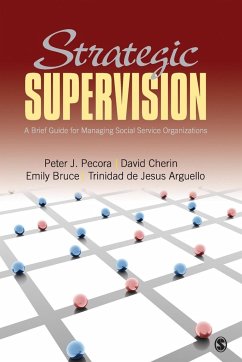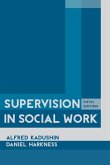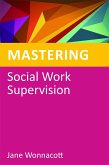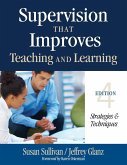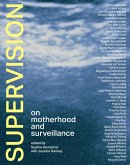Peter J. Pecora, David A. Cherin, Emily J. Bruce
Strategic Supervision
A Brief Guide for Managing Social Service Organizations
Peter J. Pecora, David A. Cherin, Emily J. Bruce
Strategic Supervision
A Brief Guide for Managing Social Service Organizations
- Broschiertes Buch
- Merkliste
- Auf die Merkliste
- Bewerten Bewerten
- Teilen
- Produkt teilen
- Produkterinnerung
- Produkterinnerung
A brief and practical guide to the most important aspects of supervisory leadership and personnel management.
Andere Kunden interessierten sich auch für
![Supervision as Collaboration in the Human Services Supervision as Collaboration in the Human Services]() Michael J. AustinSupervision as Collaboration in the Human Services195,99 €
Michael J. AustinSupervision as Collaboration in the Human Services195,99 €![Supervision in Social Work Supervision in Social Work]() Alfred KadushinSupervision in Social Work105,99 €
Alfred KadushinSupervision in Social Work105,99 €![Mastering Social Work Supervision Mastering Social Work Supervision]() Jane WonnacottMastering Social Work Supervision36,99 €
Jane WonnacottMastering Social Work Supervision36,99 €![Passionate Supervision Passionate Supervision]() Passionate Supervision32,99 €
Passionate Supervision32,99 €![Supervision That Improves Teaching and Learning Supervision That Improves Teaching and Learning]() Susan S. SullivanSupervision That Improves Teaching and Learning50,99 €
Susan S. SullivanSupervision That Improves Teaching and Learning50,99 €![Supervision Supervision]() Jessica HankeySupervision26,99 €
Jessica HankeySupervision26,99 €![The Routledge International Handbook of Social Work Supervision The Routledge International Handbook of Social Work Supervision]() The Routledge International Handbook of Social Work Supervision45,99 €
The Routledge International Handbook of Social Work Supervision45,99 €-
-
-
A brief and practical guide to the most important aspects of supervisory leadership and personnel management.
Hinweis: Dieser Artikel kann nur an eine deutsche Lieferadresse ausgeliefert werden.
Hinweis: Dieser Artikel kann nur an eine deutsche Lieferadresse ausgeliefert werden.
Produktdetails
- Produktdetails
- Verlag: SAGE Publications Inc
- Seitenzahl: 248
- Erscheinungstermin: 1. Oktober 2009
- Englisch
- Abmessung: 229mm x 152mm x 14mm
- Gewicht: 284g
- ISBN-13: 9781412915434
- ISBN-10: 1412915430
- Artikelnr.: 26254809
- Herstellerkennzeichnung
- Libri GmbH
- Europaallee 1
- 36244 Bad Hersfeld
- gpsr@libri.de
- Verlag: SAGE Publications Inc
- Seitenzahl: 248
- Erscheinungstermin: 1. Oktober 2009
- Englisch
- Abmessung: 229mm x 152mm x 14mm
- Gewicht: 284g
- ISBN-13: 9781412915434
- ISBN-10: 1412915430
- Artikelnr.: 26254809
- Herstellerkennzeichnung
- Libri GmbH
- Europaallee 1
- 36244 Bad Hersfeld
- gpsr@libri.de
Peter J. Pecora, M.S.W., Ph.D. has a joint appointment as the Managing Director of Research Services for Casey Family Programs, and Professor, School of Social Work, University of Washington, Seattle, Washington. Casey Family Programs is the largest operating foundation in the U.S. dedicated to focus on foster care and improving the child welfare system. Dr. Pecora was a line worker and later a program coordinator in a number of child welfare service agencies. He has worked to implement intensive home-based services, child welfare training, and risk assessment systems for child protective services. He also has served as an expert witness for the states of Arizona, Florida, New Mexico, Washington and Wisconsin. His co-authored books and articles focus on child welfare program design, administration, and research, including: · What works in family foster care? Identifying key components of success from an alumni follow-up study. New York City: Oxford University Press (2010) · The Child Welfare Challenge (New Jersey: Transaction de Gruyter, 1992, 2000, 2009) · Enhancing the Well Being of Children and Families Through Effective Interventions- UK and USA Evidence for Practice. (London: Jessica Kingsley Publishers, 2006) · Quality Improvement and Program Evaluation in Child Welfare Agencies: Managing Into the Next Century (Washington, DC: Child Welfare League of America, 1996) Currently, Dr. Pecora is co-leading family support and group care reform projects in California and improving youth access to evidence-based mental health services. He also coordinates a data work group as part of a national effort to reduce racial disproportionally in the child welfare system. Affiliations: -Casey Family Programs and University of Washington
Ch 1. Administrative Supervision within an Organizational Context
Introduction
Defining Supervision
Summary
Web-Based Resources
For Further Reading
Ch 2. Organizational and Workgroup Culture (David Cherin, David Chenot)
Introduction
Defining Organizational and Team Culture
Gauging the Gap: A Tool for Cultural Narratives
Providing a Cultural Narrative to Explain the Impact of Culture on the
Organization and Team
Supervisory Roles: Working in the Cultural Frame
Supervisory Roles: Working in the Cultural Frame
Frame Reflection
Positive/Appreciative Inquiry
Facilitating Team Culture
Summary
Web-Based Resources
For Further Reading
Ch 3. Value-based Principles and Laws Guiding Personnel Management
Introduction
Key Laws Guiding the Personnel Management Aspects of Supervision
Summary
For Further Reading
Ch 4. Recruiting Effective Employees
Introduction
Specifying Job Tasks and Position Descriptions
Use of Competency Statements in Supervision and Personnel Management
Recruitment and Selection Phases and Strategies
Summary
Web-Based Resources
For Further Reading
Ch 5. Screening and Interviewing for Employee Selection
Introduction
Interviewing as a Special Phase of the Recruitment and Selection Process
Completing the Selection Process: Reference Checks and Notifying Other
Applicants
Summary
Web-Based Resources
For Further Reading
Ch 6. Facilitating Groups and Teams (Jean Kruzich, Nancy Timms)
Introduction
Characteristics of Effective Work Groups
The Five Stages of Team Development
Special Aspects of Team Supervision
Team Facilitation Tools
Summary
Web-Based Resources
For Further Reading
Ch 7. Designing and Conducting Worker Performance Appraisals
Introduction
Methods of Performance Appraisal
Work Standards Appraisal Method
Management by Objectives and Results (MBO/MOR)
Developing a MOB/ MOR Performance Appraisal Plan
Planning and Conducting Performance Appraisal Conferences
Summary
Web-Based Resources
For Further Reading
Ch 8. Handling Employee Performance Problems
Introduction
Distinguishing Between Worker and Agency Factors when Diagnosing
Employee Performance Problems
Addressing Employee Performance Problems
Employee Termination
Summary
Web-Based Resources
For Further Reading
Appendices
A. Brief History of Social Work Supervision Concepts
B. Answers to the Equal Employment Opportunity Commission (EEOC) Exercise
C. Sample Position Description
D. Core Competencies for Working in a Human Services Agency
E. Planning, Leading and Coaching Professional Meetings
Introduction
Defining Supervision
Summary
Web-Based Resources
For Further Reading
Ch 2. Organizational and Workgroup Culture (David Cherin, David Chenot)
Introduction
Defining Organizational and Team Culture
Gauging the Gap: A Tool for Cultural Narratives
Providing a Cultural Narrative to Explain the Impact of Culture on the
Organization and Team
Supervisory Roles: Working in the Cultural Frame
Supervisory Roles: Working in the Cultural Frame
Frame Reflection
Positive/Appreciative Inquiry
Facilitating Team Culture
Summary
Web-Based Resources
For Further Reading
Ch 3. Value-based Principles and Laws Guiding Personnel Management
Introduction
Key Laws Guiding the Personnel Management Aspects of Supervision
Summary
For Further Reading
Ch 4. Recruiting Effective Employees
Introduction
Specifying Job Tasks and Position Descriptions
Use of Competency Statements in Supervision and Personnel Management
Recruitment and Selection Phases and Strategies
Summary
Web-Based Resources
For Further Reading
Ch 5. Screening and Interviewing for Employee Selection
Introduction
Interviewing as a Special Phase of the Recruitment and Selection Process
Completing the Selection Process: Reference Checks and Notifying Other
Applicants
Summary
Web-Based Resources
For Further Reading
Ch 6. Facilitating Groups and Teams (Jean Kruzich, Nancy Timms)
Introduction
Characteristics of Effective Work Groups
The Five Stages of Team Development
Special Aspects of Team Supervision
Team Facilitation Tools
Summary
Web-Based Resources
For Further Reading
Ch 7. Designing and Conducting Worker Performance Appraisals
Introduction
Methods of Performance Appraisal
Work Standards Appraisal Method
Management by Objectives and Results (MBO/MOR)
Developing a MOB/ MOR Performance Appraisal Plan
Planning and Conducting Performance Appraisal Conferences
Summary
Web-Based Resources
For Further Reading
Ch 8. Handling Employee Performance Problems
Introduction
Distinguishing Between Worker and Agency Factors when Diagnosing
Employee Performance Problems
Addressing Employee Performance Problems
Employee Termination
Summary
Web-Based Resources
For Further Reading
Appendices
A. Brief History of Social Work Supervision Concepts
B. Answers to the Equal Employment Opportunity Commission (EEOC) Exercise
C. Sample Position Description
D. Core Competencies for Working in a Human Services Agency
E. Planning, Leading and Coaching Professional Meetings
Ch 1. Administrative Supervision within an Organizational Context
Introduction
Defining Supervision
Summary
Web-Based Resources
For Further Reading
Ch 2. Organizational and Workgroup Culture (David Cherin, David Chenot)
Introduction
Defining Organizational and Team Culture
Gauging the Gap: A Tool for Cultural Narratives
Providing a Cultural Narrative to Explain the Impact of Culture on the
Organization and Team
Supervisory Roles: Working in the Cultural Frame
Supervisory Roles: Working in the Cultural Frame
Frame Reflection
Positive/Appreciative Inquiry
Facilitating Team Culture
Summary
Web-Based Resources
For Further Reading
Ch 3. Value-based Principles and Laws Guiding Personnel Management
Introduction
Key Laws Guiding the Personnel Management Aspects of Supervision
Summary
For Further Reading
Ch 4. Recruiting Effective Employees
Introduction
Specifying Job Tasks and Position Descriptions
Use of Competency Statements in Supervision and Personnel Management
Recruitment and Selection Phases and Strategies
Summary
Web-Based Resources
For Further Reading
Ch 5. Screening and Interviewing for Employee Selection
Introduction
Interviewing as a Special Phase of the Recruitment and Selection Process
Completing the Selection Process: Reference Checks and Notifying Other
Applicants
Summary
Web-Based Resources
For Further Reading
Ch 6. Facilitating Groups and Teams (Jean Kruzich, Nancy Timms)
Introduction
Characteristics of Effective Work Groups
The Five Stages of Team Development
Special Aspects of Team Supervision
Team Facilitation Tools
Summary
Web-Based Resources
For Further Reading
Ch 7. Designing and Conducting Worker Performance Appraisals
Introduction
Methods of Performance Appraisal
Work Standards Appraisal Method
Management by Objectives and Results (MBO/MOR)
Developing a MOB/ MOR Performance Appraisal Plan
Planning and Conducting Performance Appraisal Conferences
Summary
Web-Based Resources
For Further Reading
Ch 8. Handling Employee Performance Problems
Introduction
Distinguishing Between Worker and Agency Factors when Diagnosing
Employee Performance Problems
Addressing Employee Performance Problems
Employee Termination
Summary
Web-Based Resources
For Further Reading
Appendices
A. Brief History of Social Work Supervision Concepts
B. Answers to the Equal Employment Opportunity Commission (EEOC) Exercise
C. Sample Position Description
D. Core Competencies for Working in a Human Services Agency
E. Planning, Leading and Coaching Professional Meetings
Introduction
Defining Supervision
Summary
Web-Based Resources
For Further Reading
Ch 2. Organizational and Workgroup Culture (David Cherin, David Chenot)
Introduction
Defining Organizational and Team Culture
Gauging the Gap: A Tool for Cultural Narratives
Providing a Cultural Narrative to Explain the Impact of Culture on the
Organization and Team
Supervisory Roles: Working in the Cultural Frame
Supervisory Roles: Working in the Cultural Frame
Frame Reflection
Positive/Appreciative Inquiry
Facilitating Team Culture
Summary
Web-Based Resources
For Further Reading
Ch 3. Value-based Principles and Laws Guiding Personnel Management
Introduction
Key Laws Guiding the Personnel Management Aspects of Supervision
Summary
For Further Reading
Ch 4. Recruiting Effective Employees
Introduction
Specifying Job Tasks and Position Descriptions
Use of Competency Statements in Supervision and Personnel Management
Recruitment and Selection Phases and Strategies
Summary
Web-Based Resources
For Further Reading
Ch 5. Screening and Interviewing for Employee Selection
Introduction
Interviewing as a Special Phase of the Recruitment and Selection Process
Completing the Selection Process: Reference Checks and Notifying Other
Applicants
Summary
Web-Based Resources
For Further Reading
Ch 6. Facilitating Groups and Teams (Jean Kruzich, Nancy Timms)
Introduction
Characteristics of Effective Work Groups
The Five Stages of Team Development
Special Aspects of Team Supervision
Team Facilitation Tools
Summary
Web-Based Resources
For Further Reading
Ch 7. Designing and Conducting Worker Performance Appraisals
Introduction
Methods of Performance Appraisal
Work Standards Appraisal Method
Management by Objectives and Results (MBO/MOR)
Developing a MOB/ MOR Performance Appraisal Plan
Planning and Conducting Performance Appraisal Conferences
Summary
Web-Based Resources
For Further Reading
Ch 8. Handling Employee Performance Problems
Introduction
Distinguishing Between Worker and Agency Factors when Diagnosing
Employee Performance Problems
Addressing Employee Performance Problems
Employee Termination
Summary
Web-Based Resources
For Further Reading
Appendices
A. Brief History of Social Work Supervision Concepts
B. Answers to the Equal Employment Opportunity Commission (EEOC) Exercise
C. Sample Position Description
D. Core Competencies for Working in a Human Services Agency
E. Planning, Leading and Coaching Professional Meetings

